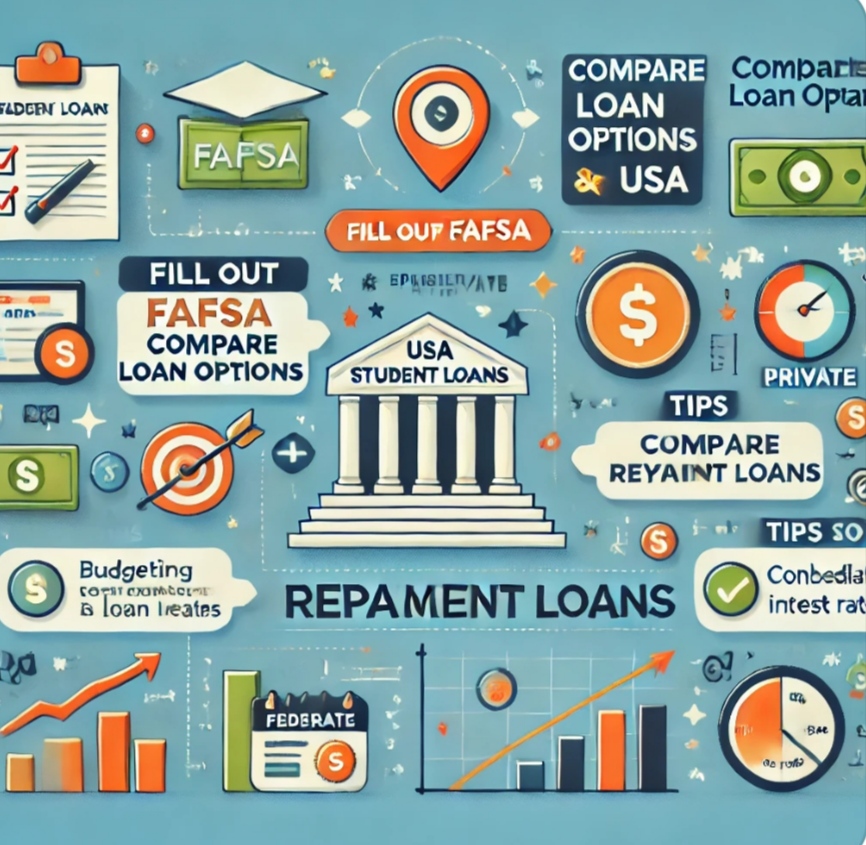Get help
Our work
Resource
#Best Student Loan Options, #FAFSA Application, #FAFSA Tips 2025, #Federal Student Loans, #Federal vs Private Loans, #How to Apply for Student Loans, #How to Manage Student Debt, #loan, #Loan Consolidation Tips, #Paying off Student Loans, #Private Student Loans, #Student Loan Forgiveness, #Student Loan Interest Rates, #Student Loan Repayment Plans, #Student Loans USA
ZeroToHero
0 Comments
How to Get Student Loans in USA and Repayment Tips: A Complete Guide
The cost of education has increased a lot these days, and many students face financial challenges to pursue their higher education. If you are considering taking a loan to fund your education, it is important that you know everything about student loans. The process of taking student loans is simple, but if you do not plan properly, you may face difficulties in repayment. In this article, we will tell you how to take student loans in USA, what options are available, and repayment tips that will help you manage your loan efficiently.
How to take Student Loans in USA? There are many ways to take student loans in USA. First you have to understand what is the difference between federal loans and private loans and which option you should choose.1. Federal Student Loans: What are they?Federal loans are provided through the USA government. These loans provide financial assistance to students for education and their terms are also quite favorable. These are some types that are available to you:
1. Federal Student Loans: What are they? Federal loans are provided through the USA government. These loans provide financial assistance to students for education and their terms are also quite favorable. These are some types that are available to you:
Direct Subsidized Loans These loans are available to those students who show financial need. Subsidized means that the government bears the burden of interest while you are in school.
Direct Unsubsidized Loans You get these loans even without financial need, but you have to pay the interest in it even during school.
Direct PLUS Loans If you are a graduate student or your parents need extra funds, they can apply for PLUS loans.
Example: If you are an undergraduate student and your financial need is high, you can get a Direct Subsidized Loan. If you are a graduate student, you can get a Direct PLUS Loan.
2. Private Student Loans: What are they? Private loans are loans that are obtained from private financial institutions such as banks and credit unions. The terms of these loans can be more strict and the interest rates can be slightly higher. You have to evaluate your credit score and income to be eligible for these loans.
Example: If you need more money than federal loans, you can take a private loan. But, you have to take the decision of taking a loan keeping in mind your credit score as well.
3. Loan Application Process: How to do it? If you want to take a student loan in the USA, then you have to follow these steps:Apply for FAFSA: First of all you have to fill the FAFSA (Free Application for Federal Student Aid) form. This form evaluates your financial need and can make you eligible for federal loans.
Example: If you want financial aid for your tuition fees and living expenses, then you have to fill the FAFSA form.
Decide the loan type: You’ll need to decide whether you want a federal loan or a private loan. Federal loans are issued through the government and have low interest rates. You can get private loans from banks or credit unions.
Estimate the loan amount: Before taking a loan, calculate your tuition fees, accommodation, books, and living expenses. Federal loans have a limit, which changes according to your grade level.
Submit a loan application: Once you decide on the loan type, you have to submit a loan application. If you are taking a federal loan, you get a loan offer through FAFSA. If you are taking a private loan, you have to contact the lender directly.
Student Loan Repayment Tips: How to Repay Efficiently? When you have taken a loan, the most important thing is repayment. If you repay the loan in the right way, you can avoid any financial tension in the future. These are some repayment tips that will help you:
1. Choose a Loan Repayment Plan When you start repaying your student loan, it’s important to first choose a repayment plan. There are several types of repayment plans available with federal student loans:
Standard Repayment Plan This requires you to make fixed monthly payments and repay the loan over 10 years.
Example: If you have a loan of $30,000 and repay over 10 years, your monthly payment would be approximately $300 (including interest rates).
Graduated Repayment Plan: In this the initial payments are low and the payments increase over time.
Income-Driven Repayment Plans: If your income is low, you get the facility to set payments according to your income.
2. Interest Payments During School If you can make interest payments during school, you can reduce the principal balance of your loan. If you don’t pay interest, the loan balance will keep increasing along with the interest.
Example: If you have taken a loan of $10,000 and pay the interest, you can pay off the principal amount of the loan quickly.
3. Set Up Automatic Payments If you set up automatic payments, you will never miss your payment. Most lenders also offer interest rate discount on automatic payments.
4. Make Extra Payments If you get extra money, you can repay your student loan quickly. Extra payments reduce your principal, which also reduces the total interest you have to pay.
5. Explore Loan Forgiveness Programs If you work in public service jobs, you may benefit from Public Service Loan Forgiveness (PSLF). Under this program, if you work in eligible public sector jobs for 10 years, your loan may be forgiven.
6. Loan Consolidation and Refinancing If you have multiple loans, then the option of loan consolidation is available, in which you can merge your loans into a single loan. The option of refinancing helps you in reducing the interest rate. This option is especially for those students who are maintaining a stable income source.
Conclusion: In the USA, student loans are an important financial tool to help you pay for higher education. If you take federal loans, their terms are quite favorable and repayment plans are flexible. If you choose private loans, you need to carefully evaluate your credit score.Managing loan repayment efficiently is equally important. Considering options such as automatic payments, extra payments, and loan forgiveness programs will save you from financial burden. If you manage your loans carefully, you can handle your educational expenses smoothly.
Disclaimer: The information provided in this article is intended for general informational purposes only and should not be considered as financial advice. While we have made every effort to ensure the accuracy of the details, individual circumstances may vary, and the content may not apply to all situations. We recommend that you consult with a financial advisor or loan expert to understand the specific loan options, repayment plans, and terms that are best suited for your personal needs.The content of this article is based on publicly available data at the time of writing. Financial regulations and loan programs may change over time, so it’s important to verify current information with official government resources or financial institutions. The author and the website are not responsible for any financial decisions made based on the information provided herein.






Post Comment